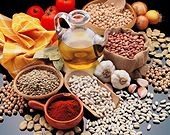Vegetarians can receive the proper proteins and nutrients they need with many health benefits. The trick? Eating meat, occasionally.
 By Hannah Canvasser LuxEco Editorial Assistant
By Hannah Canvasser LuxEco Editorial Assistant
Obesity is a current main health topic because it is unfortunately a growing one. With obesity rates rising in America many studies have aimed their focus to find the root of the problem, narrowing in on eating trends in the United States.
It was typical of my grandparent’s generation to sit down to red meat three times a day. Maybe some sausage and eggs for breakfast, a beef casserole for lunch, and meatloaf and french bread for dinner; sound a little excessive on the arteries? In 1971, Vegetarians and Vegans became popular with the publication of Frances Moore Lappé’s Diet for a Small Planet revealing the waste build up behind grain-fed meat production, and arguing that a plant diet is best for one’s body and the earth. Though Lappé was one of the first to come out with valid arguments against grain-fed meat production, being a vegetarian does have its set-backs, and receiving proper proteins and nutrients wasn’t as easy as it seemed.
Staying Flexible
 Rather than following either extreme, a recent food trend has nutritionists believing that Vegetarians can receive the proper proteins and nutrients they need with many health benefits. The trick? Eating meat, occasionally. These meat-eating Vegetarians, known as Flexitarians, have a vegetable based diet that occasionally involves meat, and are advocates because of the health benefits rather than animal rights. By staying flexible and cutting meat from your diet just once a week you can reduce your risk of chronic preventable conditions like cancer, cardiovascular disease, diabetes, and obesity, without harming your body or the environment.
Rather than following either extreme, a recent food trend has nutritionists believing that Vegetarians can receive the proper proteins and nutrients they need with many health benefits. The trick? Eating meat, occasionally. These meat-eating Vegetarians, known as Flexitarians, have a vegetable based diet that occasionally involves meat, and are advocates because of the health benefits rather than animal rights. By staying flexible and cutting meat from your diet just once a week you can reduce your risk of chronic preventable conditions like cancer, cardiovascular disease, diabetes, and obesity, without harming your body or the environment.
Taste (For even non-vegetarians)
Going meatless once a week is simple, and can be very satiating. With the right recipes and proteins, you’ll forget your meal didn’t involve meat, and your arteries will thank you. For those meat-addicts that are sweating the idea of weaning their diet, here are a few simple pointers to keep you content during your meatless meal:
1. Flavor
Just because your meal doesn’t involve meat doesn’t mean it needs to be bland! When trying new vegetarian dishes keep the seasoning profile the same as if it did have meat, and continue to spice it up! For example turn a chicken curry into a butternut squash or tofu curry, or try substituting tempeh for chicken on a barbecue chicken pizza.
2. Protein
It’s important when not eating meat to still get your protein. Some good sources of Vegetarian proteins are beans, legumes, eggs, nuts, and seeds. Don’t let the simplicity of these items fool you, they can be turned into a flavorful meal! Try an egg white breakfast burrito, or substituting bulgar wheat for meat in your favorite chili recipe.
Happy Cows
The main concept behind the Flexitarian movement is to stay flexible with your diet, and to accept that eating too much meat is bad for your health and the environment. However, it is perfectly acceptable to add meat to the diet occasionally, just look for those proteins that are grass-fed, hormone-free, and come from a local and sustainable source.
 Click here for more information on going meatless this Monday and enjoying delicious vegetarian meals.
Click here for more information on going meatless this Monday and enjoying delicious vegetarian meals.













